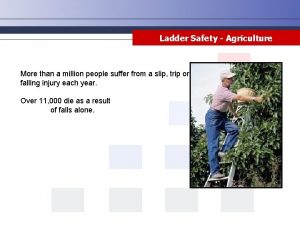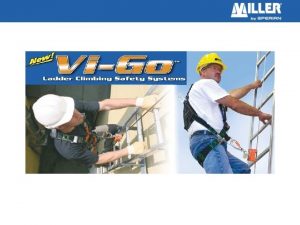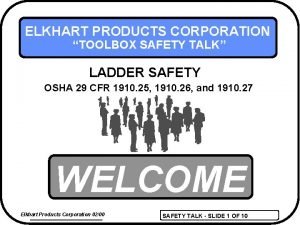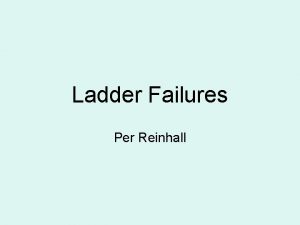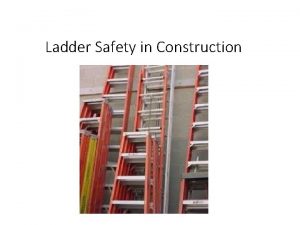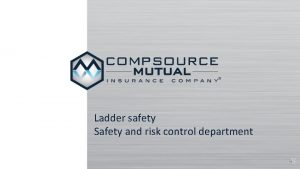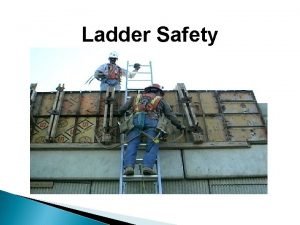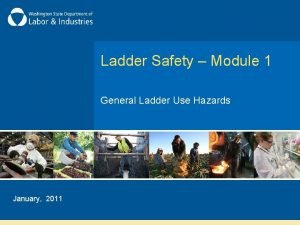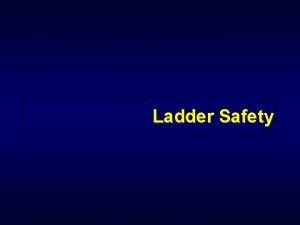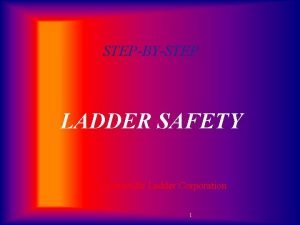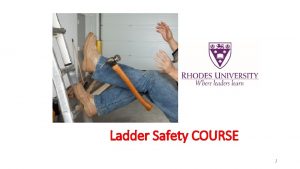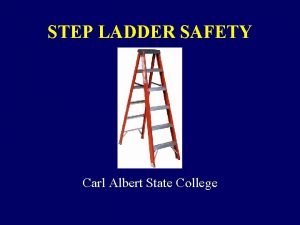Ladder Safety Agriculture More than a million people


















- Slides: 18

Ladder Safety - Agriculture More than a million people suffer from a slip, trip or falling injury each year. Over 11, 000 die as a result of falls alone.

Background • Before workers begin working from ladders, they should be properly trained. Orchard harvesting teams should include an experienced person, to simplify and expedite ladder moving. Moving ladders in the orchard can cause extra work and may lead to additional accidents. • The improper moving and lifting of tripod orchard ladders leads to many accidents including falls. • Tripod orchard ladders are designed to be used on soft and uneven terrain therefore they lack spreaders, locking devices, steel points, and safety shoes. This ladder is not a general purpose ladder and should only be used in an orchard for pruning and harvesting operations. The ladder could collapse when used on firm, smooth ground. The top of the ladder can be made of a combination of wood or metal. Only one person should be on the ladder at a time.

Did You Know that Falls Are the Most Common Accident in Agriculture? • Falls often result in serious injuries or death. • Falls of just a few feet can kill you. • Many falls occur because of slips and trips and can be avoided by wearing proper shoes and following safe work procedures.

Tripod Orchard Ladder Features • Single back leg provides relatively stable support on uneven terrain. • Steps are at least 27 inches long and should have a metal angle brace. • Maximum flare on the top to bottom rails (averaging 2. 25 inches per foot) is required to stabilize the base. • A double base on the rails is provided to control excessive penetration in soft soil. • The back of an orchard ladder should be towards the tree center, allowing for additional support if the worker slips. An orchard extension ladder should only have one person on the ladder at a time. The top of the ladder is not to be used as a step.

Orchard Extension Ladder Features • Converging rails at the top for easy fit in the limb crotch. • Virtual one-point top bearing increases stability. • Optional equipment which can be used on orchard extension ladders includes: – Steel “spikes” to prevent base slipping/skidding. – Rubber sleeves on upper rail sector to reduce branch abrasion and possibility of slip along the limb

Review the Following Points • Tripod orchard ladders are a source of many accidents. • The top of the ladder is prohibited as a step. • It is recommended that the back of an orchard ladder should be aimed toward the tree center. • Everyone using a ladder should have proper training before work begins, especially in orchards.

To Help Prevent Falls • Wear shoes and boots with slip-resistant soles and heels. • Remove tools or other items that may cause a tripping hazard from equipment. • Keep platforms, foot-plates, and steps clear of mud, snow, manure, or other debris. • Do not get out of equipment such as a tractor before it has completely stopped and the brakes are set. Step down using handholds or rails. Never jump off a tractor (moving or not) except if tractor comes into contact with energized power lines, then jump as far away as possible and shuffle away from where you jumped. • Examine ladders to ensure they are in good condition. Wood ladders should not be painted because this may disguise flaws or weak areas in the wood. Use the "four-to-one rule" for straight ladders, setting the ladder base one foot from a wall or building for each four feet in height.

When Working On Ladders • Keep a hold of ladder. • Do not overreach. • Keep your belt buckle between the ladder rungs. • Do not put one foot on the ladder and the other on an adjacent surface or object. • Do not jump down. • Avoid climbing a ladder in wet or icy conditions. • Be aware of power lines and avoid them. • Do not work in high places when the weather is windy or stormy or when you are ill, tired, or taking strong medication.

Ladders, Lifting, and Falls • Lift with the legs, not the back. • Visually inspect a ladder before using it. • Make sure the ladder has a secure footing before climbing. • Always use caution around electrical wire or connectors.

Accident Response Have A Plan! • Employers should have an appropriate emergency response plan. This includes work crews being trained to call 911 and to not move an injured worker suspected of having a neck or spinal injury. • Also, supervisors and workers should be trained in first aid and cardiopulmonary resuscitation (CPR). • Field crews should be issued portable communication devices to use in emergencies.

Ladder Hazards Ladder accidents usually are caused by improper selection, care or use, not by manufacturing defects. Some of the more common hazards involving ladders, such as instability, electrical shock, and falls, can be predicted and prevented. Prevention requires proper planning, correct ladder selection, good work procedures and adequate ladder maintenance.

Prevention Tips • • • Do not hand-carry loads on a ladder. Do not try reaching so far that you lose your balance; move the ladder. Non-skid feet or spurs may prevent a ladder from slipping on a hard, smooth surface. Do not stand on the ladder's top three rungs. A damaged side rail may cause one side of a ladder to give way. The base should be spaced 1 foot away for every 4 feet it reaches up (see Figure 1). Ladders used to reach a walking surface or roof must extend at least 3 feet beyond. Extension ladders need both locks holding to prevent overloading a rail. Step ladders should be securely spread open. Never use a folding step ladder in an unfolded position. Electrical shock can occur with metal or wet wooden ladders. Not only is the shock itself dangerous, but it can cause falls resulting in injury.

Helpful Hints • When working on cylindrical objects like poles and columns, the top rung of portable ladders can be replaced with chain or rope to reduce rocking. • Aluminum ladders are very corrosion-resistant, but exposing them to fertilizer can cause damage. • Use the ladder inspection checklist to remind yourself of what you should look out for in order to prevent accidents.

Ladder Selection • Portable ladders are designed as "one-man" equipment with the proper strength to support the worker as well as his tools and materials. Ladders are constructed under three general classes: • Type I Industrial - Heavy-duty with a load capacity not more than 250 pounds • Type II Commercial - Medium-duty with a load capacity not more than 225 pounds (suited for painting and similar tasks) • Type III Household - Light-duty with a load capacity of 200 pounds

Ladder Maintenance • Wood ladders should be protected with a clear sealer varnish, shellac, linseed oil or wood preservative. Wood ladders should not be painted, because the paint could hide defects. Check carefully for cracks, rot, splinters, broken rungs, loose joints and bolts and hardware in poor condition. • Aluminum or steel ladders should be inspected for rough burrs and sharp edges before use. Inspect closely for loose joints and bolts, faulty welds and cracks. Make sure the hooks and locks on extension ladders are in good condition. Replace worn or frayed ropes on extension ladders at once. • Fiberglass ladders should have a surface coat of lacquer maintained. If it is scratched beyond normal wear, it should be lightly sanded before applying a coat of lacquer.

Ladder Inspection Checklist General Needs repair O. K. Date repaired Loose steps or rungs (considered loose if they can be moved at all with the hand)? _________ Loose nails, screws, bolts, or other metal parts? _________ Cracked, spilt, or broken uprights, braces, or rungs? _________ Slivers on uprights, rungs, or steps? _________ Damaged or worn non-slip bases? _________ Wobbly (from side strain)? _________ Loose or bent hinge spreaders? _________ Stop on hinge spreaders broken? _________ Loose hinges? _________ Broken, split, or worn steps? _________ Loose, broken, or missing extension locks? _________ Defective locks that do not seat properly while extended? _________ Worn or rotted part? _________ Step ladders Extension ladders

Other Approaches to Avoid Trips and Falls by Workers • Perform preventative maintenance in the off-season. • Encourage workers to practice safety by cleaning dust and debris from steps or platforms. • Keep entrances to buildings clear. Be sure steps to equipment are free of mud, ice, and snow build-up. • Allow extra time to feed livestock and hitch equipment in muddy or wet condition. Trips and falls occur much more frequently when you are in a hurry. • Encourage workers to wear shoes with a solid, slipresistant tread. Good traction reduces the chance of slipping and falling. • Maintain all ladders in good condition. • Use locking covers or pull-down section for the first 6 to 8 feet of permanent ladders.

Ladder Safety - Agriculture This form documents that the training specified above was presented to the listed participants. By signing below, each participant acknowledges receiving this training. Organization: Trainer: Trainer’s Signature: Class Participants: Name: Signature: Date: Name: Signature: Date: Name: Signature: Date: Name: Signature: Date:
 More more more i want more more more more we praise you
More more more i want more more more more we praise you More more more i want more more more more we praise you
More more more i want more more more more we praise you Anopheles
Anopheles Er than more than
Er than more than Half life more than 2 less than 4
Half life more than 2 less than 4 It is greater than god and more evil
It is greater than god and more evil Who was the long awaited friend of anne why
Who was the long awaited friend of anne why Sixty million and more
Sixty million and more 67 million people
67 million people Impersonal passive rules
Impersonal passive rules Tripod inspection checklist
Tripod inspection checklist Safety colors in agriculture
Safety colors in agriculture Virginia department of agriculture and consumer services
Virginia department of agriculture and consumer services Ohio cottage food law label
Ohio cottage food law label Vi go ladder climbing safety systems
Vi go ladder climbing safety systems Double-cleated ladder
Double-cleated ladder Trestle ladder safety
Trestle ladder safety Ladder safety toolbox talk
Ladder safety toolbox talk Hudson culture ladder
Hudson culture ladder










